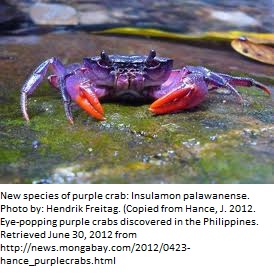 The Philippines, dubbed as the Pearl of the Orient Seas, is indeed a precious ecological habitat of a diverse species of organisms in the Southeast Asian region. Recent biological expeditions in the various parts of the country have discovered several new species of vertebrates and invertebrates. Since 2003, local and foreign biologists have identified hundreds of new species from ants to sharks, and rediscovered previously identified locally extinct bird species, proving that the Philippines is indeed an ecological hotspot in the Asian region.
The Philippines, dubbed as the Pearl of the Orient Seas, is indeed a precious ecological habitat of a diverse species of organisms in the Southeast Asian region. Recent biological expeditions in the various parts of the country have discovered several new species of vertebrates and invertebrates. Since 2003, local and foreign biologists have identified hundreds of new species from ants to sharks, and rediscovered previously identified locally extinct bird species, proving that the Philippines is indeed an ecological hotspot in the Asian region.
Among the species discovered recently are the following:
- 40 ant species that belong to 11 different genera, bringing the total genera of ants in the country to 92. The study was conducted by David General and his colleagues in a forested area in Luzon Island (Read More)
- inflatable shark, 50 colorful new sea slugs, dozens of new insects and spiders, and a number of deep-sea armored corals, which were discovered during the 2011 Philippine Biodiversity Expedition (Read More)
- two new frog species, which were found in the Mount Nacolod mountain range in Southern Leyte (Read More)
- four new species of freshwater crabs in small, lowland-forest ecosystems in the Palawan island group (Read More)
Among the re-discovered bird species are the following: red jungle fowl, pink-necked green pigeon, black-chinned fruit dove, pink-bellied imperial pigeon, metallic wood pigeon, Philippine hawk owl, Northern boobook, variable kingfisher, white-throated kingfisher, Philippine swiftlet, Philippine needletail, dollarbird, citrine canary flycatcher,lemon-throated warbler, plain-throated sunbird, and Philippine pygmy flowerpecker (Read More).
These discoveries and re-discoveries of species in the country indicate that the Philippines has performed an important role in the conservation and protection of globally important species. And this calls a concerted effort among the scientists, conservationists, environmentalists, government officials, academicians, decision-makers, politicians, business people, media people, and even the community to conserve and protect these precious jewels in the country. (Ricardo T. Bagarinao)

Leave a Reply